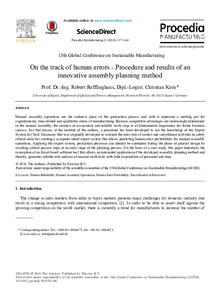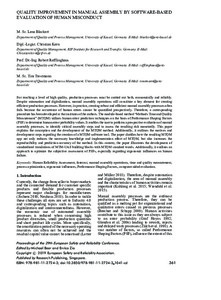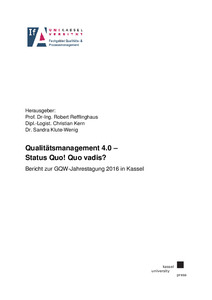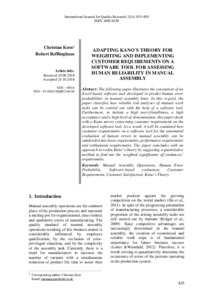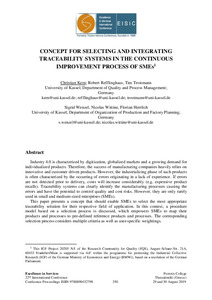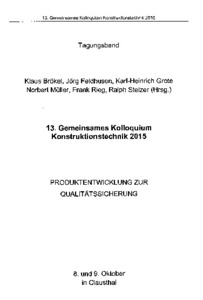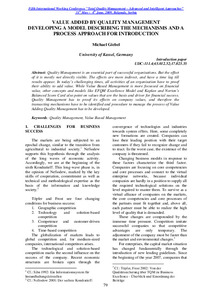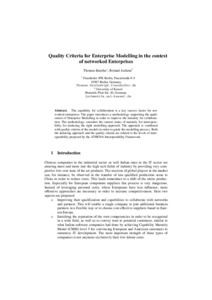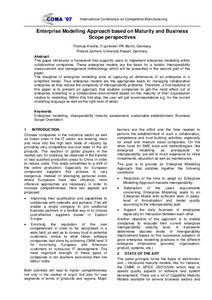Suche
Anzeige der Dokumente 1-10 von 17
Aufsatz

 On the track of human errors - Procedure and results of an innovative assembly planning method
On the track of human errors - Procedure and results of an innovative assembly planning method
(2018-03-07)
Manual assembly operations are the endmost place of the production process and with it represent a melting pot for organizational, time-related and qualitative errors of manufacturing. Because competitive advantages are increasingly determined in the manual assembly, the creation of economical and reliable work steps is of fundamental importance for future business success. For that reason, at the institute of the authors, a procedure has been developed to use the knowledge of the Expert System for Task Taxonomy that ...
Konferenzveröffentlichung
 Quality Improvement In Manual Assembly By Software-Based Evaluation Of Human Misconduct
Quality Improvement In Manual Assembly By Software-Based Evaluation Of Human Misconduct
(European Safety and Reliability Association, 2019)
For reaching a level of high quality, production processes must be carried out both, economically and reliably. Despite automation and digitalization, manual assembly operations still constitute a key element for creating efficient production processes. However, in practice, creating robust and efficient manual assembly processes often fails because the occurrence of human errors cannot be quantified prospectively. Therefore, a corresponding procedure has been developed at the institutes of the authors. The module-based ...
Teil eines Buches
 Analyse der menschlichen Zuverlässigkeit für manuelle Montagetätigkeiten
Analyse der menschlichen Zuverlässigkeit für manuelle Montagetätigkeiten
(Beuth Verlag GmbH, 2019)
Während sich Fehlerraten von Maschinen und Robotern regelmäßig im Promillebereich bewegen, fällt bei manuellen Montagetätigkeiten auf, dass manche Arbeitsschritte deutlich fehleranfälliger sind als andere. Da eine prospektive Auseinandersetzung mit der Zuverlässigkeit des Menschen im Montageprozess in der betrieblichen Praxis bisher weitestgehend vernachlässigt wurde, stellt der folgende Beitrag einen prozessorientierten Ansatz zur qualitativen und quantitativen Analyse der menschlichen Zuverlässigkeit bei manuellen ...
Teil eines Buches

 Anforderungsklassifizierung in der Fahrdynamik und Fahrerassistenz als Grundlage einer kundenorientierten Produktqualität und Kundenzufriedenheit
Anforderungsklassifizierung in der Fahrdynamik und Fahrerassistenz als Grundlage einer kundenorientierten Produktqualität und Kundenzufriedenheit
(kassel university press, 2016)
Die BMW Group zählt zu den weltweit führenden Herstellern von Premiumprodukten und Anbietern von Mobilitätsdienstleistungen in der Automobilindustrie. Durch zunehmende Qualitätsansprüche der Kunden gewinnt auch die Anforderungsklassifizierung an Bedeutung. Gerade in Zeiten steigenden Wettbewerbsdrucks und kürzeren Innovationszyklen ist eine genaue Kenntnis der kundenseitigen Anforderungsmerkmale und deren Auswirkungen auf die produktbezogene Qualitätswahrnehmung und Kundenzufriedenheit von großer Bedeutung. Die ...
Aufsatz

 Adapting Kano's Theory for weighting and implementing customers requirements on a software tool for assessing human reliability in manual assembly
Adapting Kano's Theory for weighting and implementing customers requirements on a software tool for assessing human reliability in manual assembly
(2018)
The following paper illustrates the conception of an Excel-based software tool developed to predict human error probabilities in manual assembly lines. In this regard, the paper clearifies how reliable risk analyses of manual work tasks can be carried out with the help of a software tool. Furthermore, to initiate a high user-friendliness, a high acceptance and a high level of dissemination, this paper deals with a Kano survey concerning customer requirements on the developed software tool. As a result, it will be ...
Konferenzveröffentlichung

 Concept for selecting and integrating traceability systems in the continuous improvement process of SMEs
Concept for selecting and integrating traceability systems in the continuous improvement process of SMEs
(2019)
Industry 4.0 is characterized by digitization, globalized markets and a growing demand for individualized products. Therefore, the success of manufacturing companies heavily relies on innovative and customer driven products. However, the industrializing phase of such products is often characterized by the occurring of errors originating in a lack of experience. If errors are not detected prior to delivery, costs will increase considerably (e.g. expensive product recalls). Traceability systems can clearly identify the ...
Konferenzveröffentlichung

 Verbesserung der Produktqualität durch eine frühe Anforderungsvalidierung mithilfe der virtuellen Realität
Verbesserung der Produktqualität durch eine frühe Anforderungsvalidierung mithilfe der virtuellen Realität
(Otto-von-Guericke-Universität, Fakultät für Maschinenbau, 2015)
If features meet customer requirements to 100%, one speaks about quality. In the context of the requirement identification various methods are used to generate the conscious customer requirements. Hidden (unconscious) customer requirements are not taken into account. From collected customer requirements, however, the later features can be derived. Therefore, in the developed product it often comes to a deviation from the characteristics required by the customer. Any deviation results in a lower product quality. The ...
Teil eines Buches
 Value Added by Quality Management
Value Added by Quality Management
(2009-06)
Abstract: Quality Management is an essential part of successful organisations. But the effect of it is mostly not directly visible. The effects are more indirect, and have a time lag till results appear. In today’s challenging times, all activities of an organisation have to proof their ability to add value. While Value Based Management is more focussed on financial value, other concepts and models like EFQM Excellence Model and Kaplan and Norton’s Balanced Score Card also point on values that are the basis and driver ...
Aufsatz
 Quality Criteria for Enterprise Modelling in the context of networked Enterprises
Quality Criteria for Enterprise Modelling in the context of networked Enterprises
(2007-01-22)
The capability for collaboration is a key success factor for networked enterprises. The paper introduces a methodology supporting the application of Enterprise Modelling in order to improve the maturity for collaboration. The methodology considers the current status of maturity for interoperability for deducing the right modelling approach. The approach is combined with quality criteria of the models in order to guide the modelling process. Both the deducing approach and the quality criteria are related to the levels ...
Working paper
 Enterprise Modelling Approach based on Maturity and Business Scope perspectives
Enterprise Modelling Approach based on Maturity and Business Scope perspectives
(2008-02-19)
This paper introduces a framework that supports users to implement enterprise modelling within collaborative companies. These enterprise models are the basis for a holistic interoperability measurement and management methodology which will be presented in the second part of the paper.
The discipline of enterprise modelling aims at capturing all dimensions of an enterprise in a simplified model. Thus enterprise models are the appropriate basis for managing collaborative enterprise as they reduce the complexity of ...

